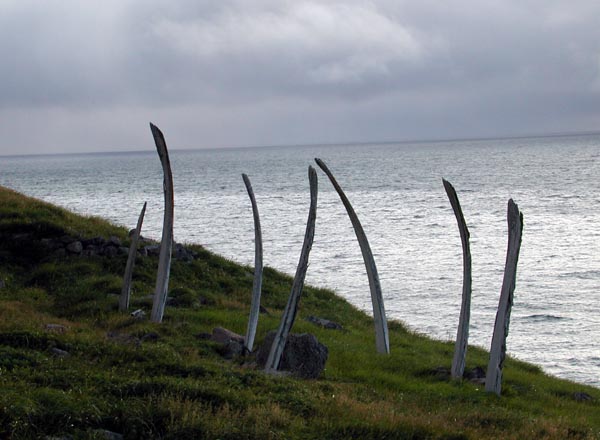Naukan people on:
[Wikipedia]
[Google]
[Amazon]
The Naukan, also known as the Naukanski, are a
 Traditionally Naukan people hunted
Traditionally Naukan people hunted
"Northeast Siberian."
''Alaska Native Collections.'' Accessed 9 Feb 2014.
Naukan abandoned Village on Cape Dezhnev Peninsula, Siberia
photo gallery {{DEFAULTSORT:Naukan People Ethnic groups in Siberia Chukchi Sea Indigenous small-numbered peoples of the North, Siberia and the Far East Siberian Yupik
Siberian Yupik people
Siberian Yupiks, or Yuits (russian: Юиты), are a Yupik people who reside along the coast of the Chukchi Peninsula in the far northeast of the Russian Federation and on St. Lawrence Island in Alaska. They speak Central Siberian Yupik ...
and an indigenous people of Siberia
Siberia, including the Russian Far East, is a vast region spanning the northern part of the Asian continent, and forming the Asiatic portion of Russia. As a result of the Russian conquest of Siberia (17th to 19th centuries) and of the subseque ...
. They live in the Chukotka Autonomous Region of eastern Russia
Russia (, , ), or the Russian Federation, is a List of transcontinental countries, transcontinental country spanning Eastern Europe and North Asia, Northern Asia. It is the List of countries and dependencies by area, largest country in the ...
.
Language
TheNaukan Yupik language
Naukan Yupik language or Naukan Siberian Yupik language (Naukan Yupik: Nuvuqaghmiistun) is a critically endangered Eskimo language spoken by ca. 70 Naukan persons (''нывуӄаӷмит'') on the Chukotka peninsula. It is one of the four Yupik ...
is a Yupik language
The Yupik languages () are a family of languages spoken by the Yupik peoples of western and south-central Alaska and Chukotka. The Yupik languages differ enough from one another that they are not mutually intelligible, although speakers of one ...
, belonging to the Eskimo–Aleut languages
The Eskaleut (), Eskimo–Aleut or Inuit–Yupik–Unangan languages are a language family native to the northern portions of the North American continent and a small part of northeastern Asia. Languages in the family are indigenous to parts of w ...
. Many Naukan people now speak the Chukchi language
Chukchi , also known as Chukot, is a Chukotko-Kamchatkan languages, Chukotko–Kamchatkan language spoken by the Chukchi people in the easternmost extremity of Siberia, mainly in Chukotka Autonomous Okrug. The language is closely related to Koryak ...
.
Culture
 Traditionally Naukan people hunted
Traditionally Naukan people hunted sea mammal
The sea, connected as the world ocean or simply the ocean, is the body of salty water that covers approximately 71% of the Earth's surface. The word sea is also used to denote second-order sections of the sea, such as the Mediterranean Sea, ...
s. Guests from remote settlements traveled from remote settlements to participate in ''pol'a, the month-long Naukan whale festival.
History
Archaeological evidence places the Naukan on theChukotka Peninsula
The Chukchi Peninsula (also Chukotka Peninsula or Chukotski Peninsula; russian: Чуко́тский полуо́стров, ''Chukotskiy poluostrov'', short form russian: Чуко́тка, ''Chukotka''), at about 66° N 172° W, is the eastern ...
off the Bering Sea
The Bering Sea (, ; rus, Бе́рингово мо́ре, r=Béringovo móre) is a marginal sea of the Northern Pacific Ocean. It forms, along with the Bering Strait, the divide between the two largest landmasses on Earth: Eurasia and The Ameri ...
back 2,000 years. They used to live on Big Diomede Island
, image_name = Bigdiomecropped.jpg
, image_caption = Big Diomede seen from its nearest neighbor, Little Diomede
, map_caption =
, locator_map_size =
, nickname =
, location = Bering Strait
, coordinates =
, archipelago =Diomede Isla ...
and Cape Dezhnev
Cape Dezhnyov or Cape Dezhnev (; ), formerly known as East Cape or Cape Vostochny, is a cape that forms the easternmost mainland point of Asia. It is located on the Chukchi Peninsula in the very sparsely populated Chukotka Autonomous Okrug of ...
in the Bering Strait. The Soviet Union
The Soviet Union,. officially the Union of Soviet Socialist Republics. (USSR),. was a transcontinental country that spanned much of Eurasia from 1922 to 1991. A flagship communist state, it was nominally a federal union of fifteen national ...
relocated Naukan people from their traditional coastal village of Naukan in 1958.Ainana, Ludmila, Tatiana Achirgina-Arsiak, and Tasian Tein"Northeast Siberian."
''Alaska Native Collections.'' Accessed 9 Feb 2014.
See also
*Yaranga
A Yaranga ( Chukchi: ) is a tent-like traditional mobile home of some nomadic Northern indigenous peoples of Russia, such as Chukchi and Siberian Yupik.
A Yaranga is a cone-shaped or rounded reindeer-hide tent. It is built of a light wooden fr ...
, a conical reindeer-hide tent
* Central Siberian Yupik language
Central Siberian Yupik, (also known as Siberian Yupik, Bering Strait Yupik, Yuit, Yoit, "St. Lawrence Island Yupik", and in Russia "Chaplinski Yupik" or Yuk) is an endangered Yupik language spoken by the indigenous Siberian Yupik people along the ...
* Sirenik Yupik
Sirenik or ''Sireniki'' are former speakers of a divergent Eskimo language in Siberia, before its extinction. The total language death of this language means that now the cultural identity of Sirenik Eskimos is maintained through other aspects: s ...
* Yupik peoples
The Yupik (plural: Yupiit) (; russian: Юпикские народы) are a group of indigenous or aboriginal peoples of western, southwestern, and southcentral Alaska and the Russian Far East. They are related to the Inuit and Iñupiat. Yup ...
* Indigenous small-numbered peoples of the North, Siberia and the Far East The indigenous small-numbered peoples of the North, Siberia and the Far East (russian: коренные малочисленные народы Севера, Сибири и Дальнего Востока) is a Russian census classification of indi ...
Notes
External links
Naukan abandoned Village on Cape Dezhnev Peninsula, Siberia
photo gallery {{DEFAULTSORT:Naukan People Ethnic groups in Siberia Chukchi Sea Indigenous small-numbered peoples of the North, Siberia and the Far East Siberian Yupik